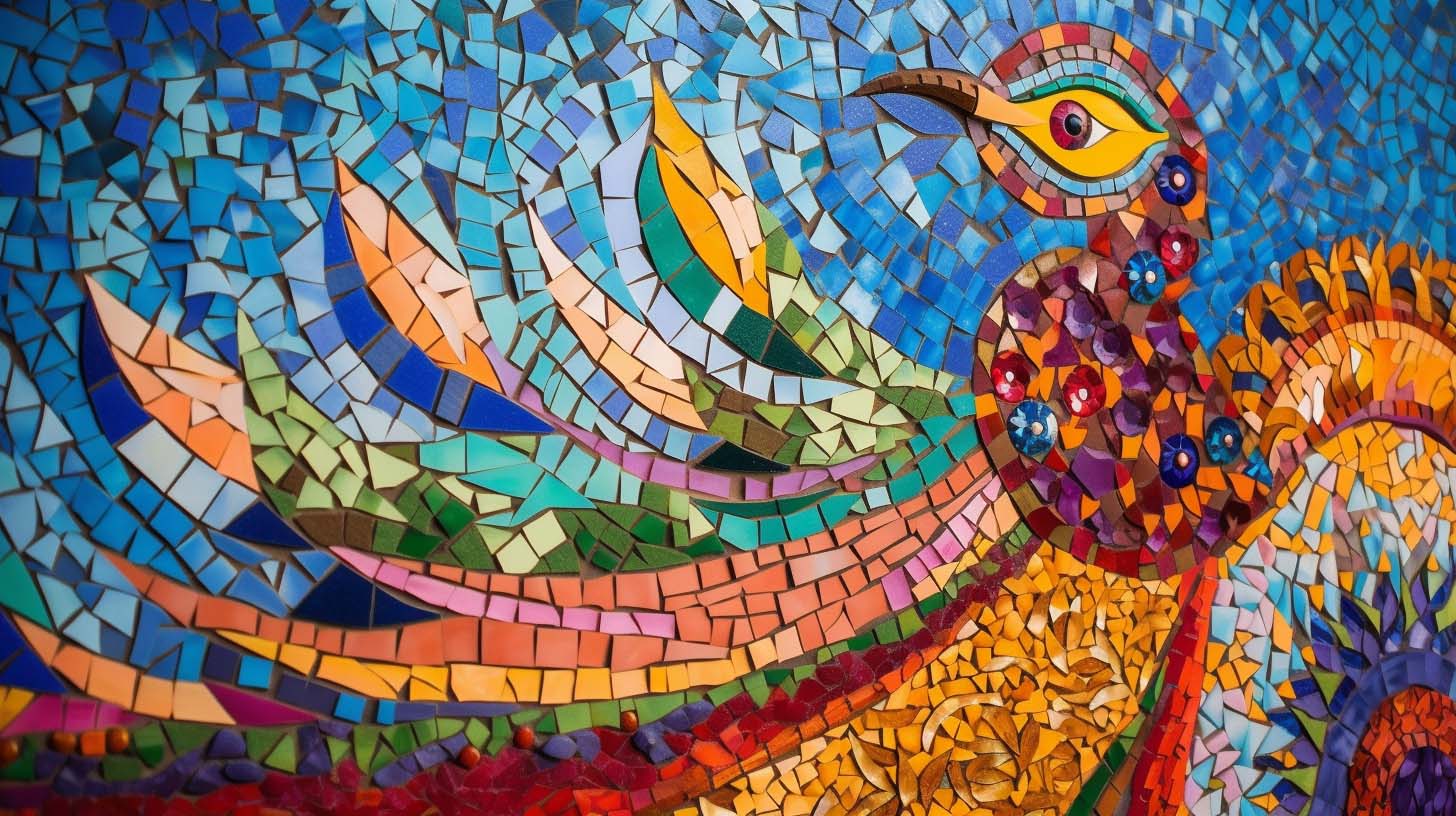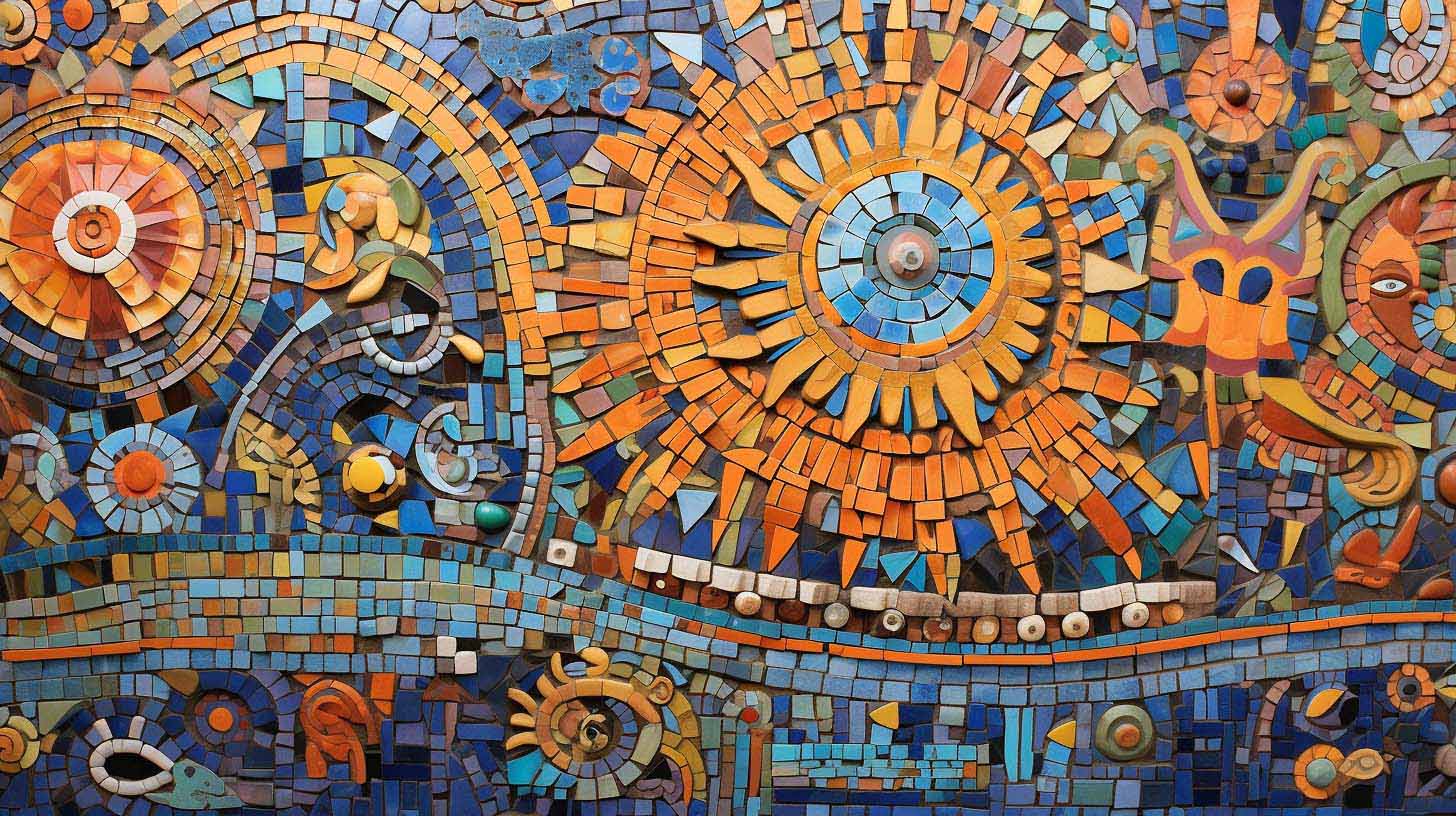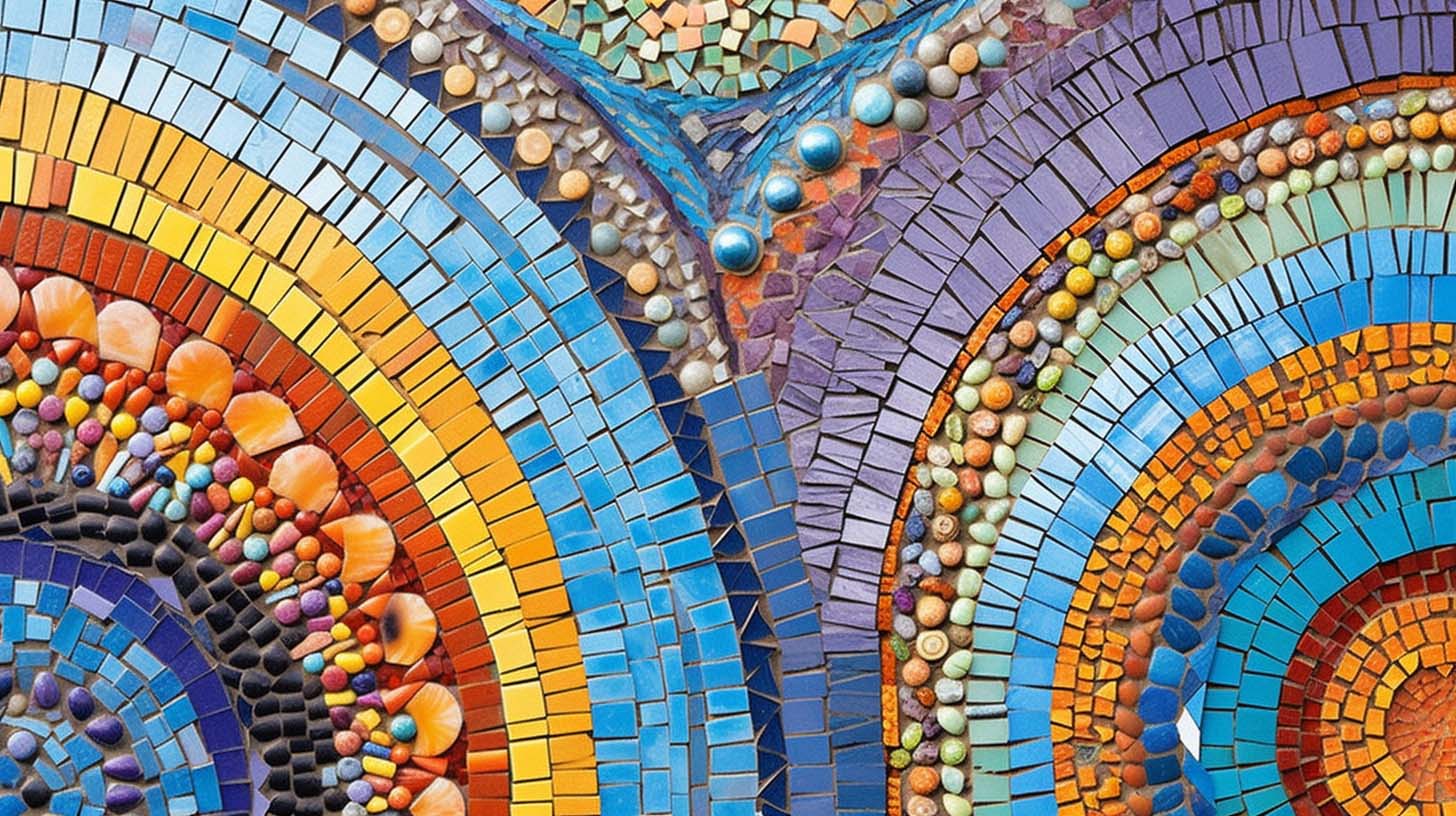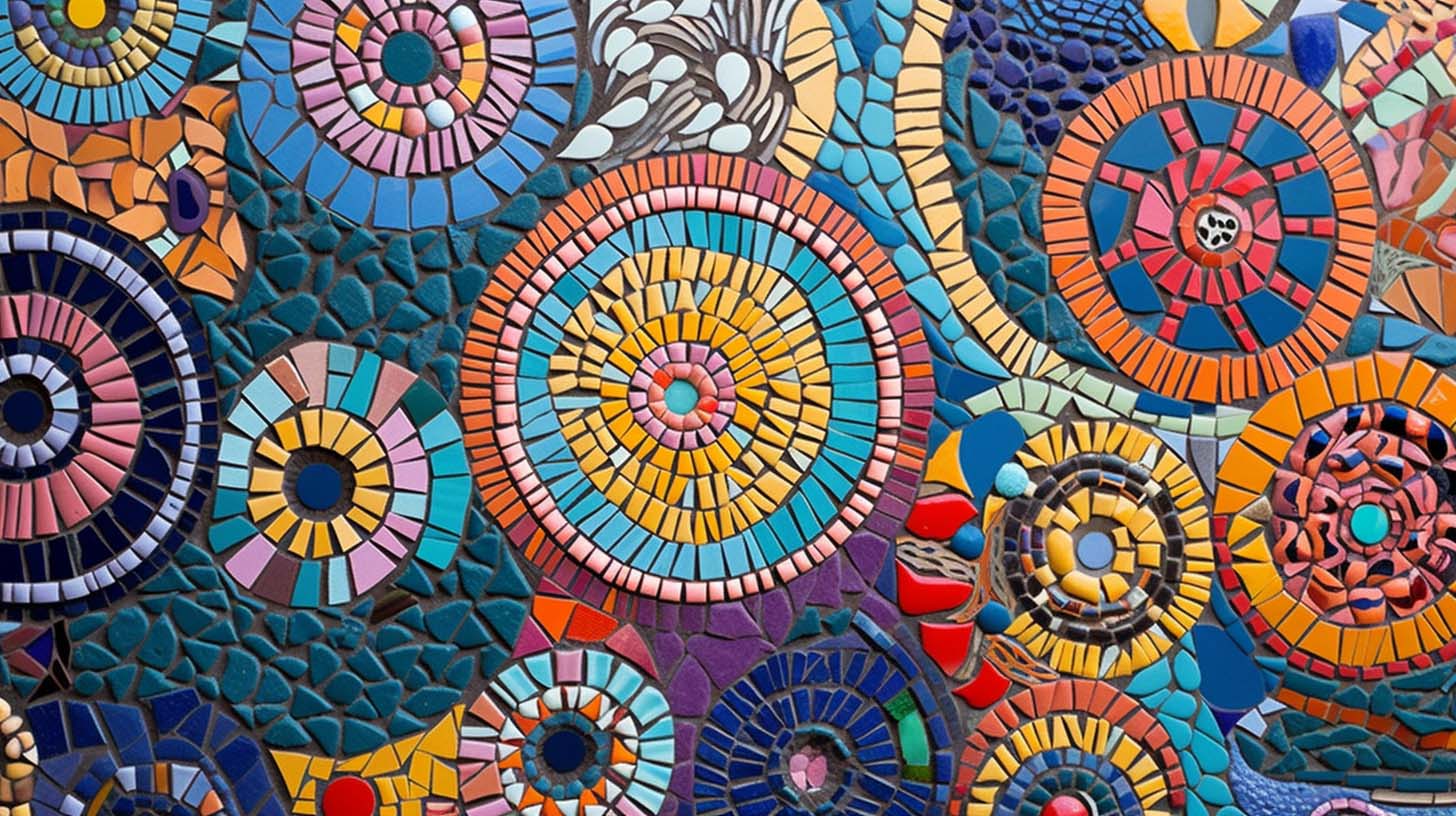Mosaics have been a part of ancient art for thousands of years.
Their use has been seen in many cultures and civilizations, from the Egyptians to the Byzantines and to the Romans.
Mosaics have been used for both decorative and symbolic purposes, offering a unique aesthetic to the viewer.
This article will explore the history and heritage of mosaic art, tracing its roots to the ancient Egyptians, and detailing the materials, techniques, and symbolic representations that have been used throughout time.
By examining the rich history and heritage of mosaic art, readers will gain a deep appreciation for this creative form of art.

- Mosaics have been a significant part of ancient art in various civilizations, including ancient Egypt, the Byzantine Empire, and Rome.
- Mosaics were used for decorative and symbolic purposes, often featuring religious iconography and motifs.
- Different materials and techniques were used in creating mosaics, such as glass, stone, and marble tesserae, as well as opus vermiculatum and opus tessellatum.
- Mosaic art conveyed religious, cultural, and political values through the use of symbolic representations and geometric shapes.
Ancient Egyptian mosaics were created using a variety of materials and techniques, offering a unique insight into the culture and beliefs of this ancient civilization.
During the Ptolemaic Period, the art of mosaic making was used to decorate both public and private spaces, such as tombs, palaces, and temples.
Coptic art was also a major influence on the art of mosaics, as evidenced by the intricate and colorful designs.
Mosaics from this period often feature religious symbols and motifs, demonstrating the importance of faith and spirituality in ancient Egyptian society.
The use of vibrant colors and delicate details has made Ancient Egyptian mosaics some of the most captivating works of art in history.
As a result, these works offer a unique glimpse into the culture and heritage of this ancient civilization.
With this in mind, it is easy to understand why the Byzantine Empire also embraced the art of mosaic making.

The Byzantine Empire was renowned for its intricate and ornate architectural designs, which were largely created using a variety of materials, including stone, glass, and marble.
Mosaic art was a prominent aspect of these designs, with much of the artwork featuring religious iconography. Mosaics depicted scenes from the Bible, as well as Byzantine royalty and depictions of other important figures.
Many of the mosaics were incredibly detailed and featured a variety of vibrant colors, making them truly exquisite works of art.
The mosaic artwork was integral in helping to spread the message of the religion throughout the empire, and the use of mosaic art continues to be an important part of Byzantine architecture today.
As such, it is clear that the Byzantine Empire had a lasting legacy on mosaic art, one that continues to influence the art form today.
Transitioning into the Roman Empire, mosaics were also used to express their religious beliefs.
Mosaic-based art was a prominent feature of Roman culture, and many of these works of art were used to communicate religious messages to the public.
During this period, there was a resurgence of mosaic art, which was heavily influenced by the Renaissance Revival and Islamic influences.
The Romans were known for their intricate designs, which were often composed of glass, stone, and marble tesserae. These materials were carefully chosen and arranged in order to create a finished product that was both aesthetically pleasing and meaningful to the viewers.
The Romans also developed a sophisticated system of techniques and processes that enabled them to produce complex and detailed works of art that could be appreciated for centuries.
By combining the Renaissance Revival and Islamic influences with their own material and techniques, the Romans were able to create a unique form of mosaic art that was both beautiful and meaningful.
This art form has since been admired by generations of art lovers and continues to be admired today.

By utilizing glass, stone, and marble tesserae, the Romans developed a wide range of mosaic-crafting techniques and processes to create intricate and detailed works of art. Their superior technique involved the careful selection of tesserae in order to achieve different effects, such as gradients, shadows, and highlights.
Color palettes were carefully chosen with associative symbolism in mind, as the Romans believed that certain colors could invoke certain emotions and ideas. Furthermore, the placement of tesserae was crucial in achieving the desired results. The Romans incorporated multiple layers of tesserae in order to provide more dimension and to produce a more realistic effect.
The Romans also developed a variety of mosaic-making techniques such as opus vermiculatum, which involved the use of small pieces of tesserae in order to create intricate patterns and designs. Additionally, opus tessellatum was used to create geometric patterns and borders.
These techniques allowed the Romans to create beautiful, intricate works of art that still inspire awe to this day. With their mastery of the techniques and materials, the Romans were able to create a lasting legacy of mosaic art that continues to be appreciated and admired.
Transitioning into the subsequent section, the symbolic representations used in Roman mosaics are equally as impressive and captivating.
Roman mosaics often featured significant symbolic representations to communicate various messages. These representations have usually been used as a means to express the significance, values, and culture of a particular society.
The perpetual significance of these symbols can still be seen in the modern world, as they have become embedded in our cultural narratives. Many iconic symbols, such as the laurel wreath, the cross, and the Greek key, were used to convey a wide range of meanings and stories. They symbolized religious, cultural, and political values, as well as the eternal cycle of life and death.
Additionally, the use of geometric shapes, such as the circle and square, were used to represent infinity, balance, and order. Through their symbolic representations, mosaics have been able to convey a variety of messages, without the need for words.

Creating a mosaic masterpiece typically requires a substantial commitment of time, skill, and materials. The complexity of the design, materials used, and techniques employed can significantly affect the timeline. Pieces can range from relatively simple to highly intricate, necessitating different amounts of time to complete. It is therefore difficult to provide an exact estimate of how long it will take.
Today, mosaic art is found in both traditional and modern designs. From ancient mosaics to contemporary works, creative artisans are crafting beautiful pieces in public and private settings. Mosaic art can be discovered in galleries, public installations, and online. With its unique blend of aesthetics and craftsmanship, mosaic art is sure to captivate and inspire.
Mosaic art is an ancient form of decorative art, with the earliest examples found in Ancient Roman and Byzantine mosaics. These mosaics featured intricate designs, created from small pieces of glass, stone, and other materials. Today, mosaic art is still popular and can be found in a variety of forms, from traditional to modern and abstract.
Mosaic art can pose safety risks, including dust inhalation and eye, skin, and respiratory irritation. Wearing protective equipment, such as gloves, goggles, and a mask, is recommended when handling materials. Taking necessary precautions can help avoid potential health risks.
Commissioning a mosaic masterpiece can be a costly endeavor, due to the material costs and time investment required. An innovative approach is necessary to ensure the highest quality outcome for an audience that desires creativity, analysis, and attention to detail.
Mosaic art has been used as a powerful form of expression in many cultures throughout history. As a medium, it has been used to express religious symbolism, convey political messages, and capture the beauty of the natural world.
From the intricate designs of the Ancient Egyptians to the intricate mosaics of the Roman Empire, the art of mosaic has been woven into the fabric of time. Through its symbolic representations, it has also been used to transmit cultural values and represent the beauty of the human experience.
Mosaic art is a testament to the lasting impact of human creativity and ingenuity. It is a living testament to the power of art as a vehicle to express the beauty and complexity of the human experience.